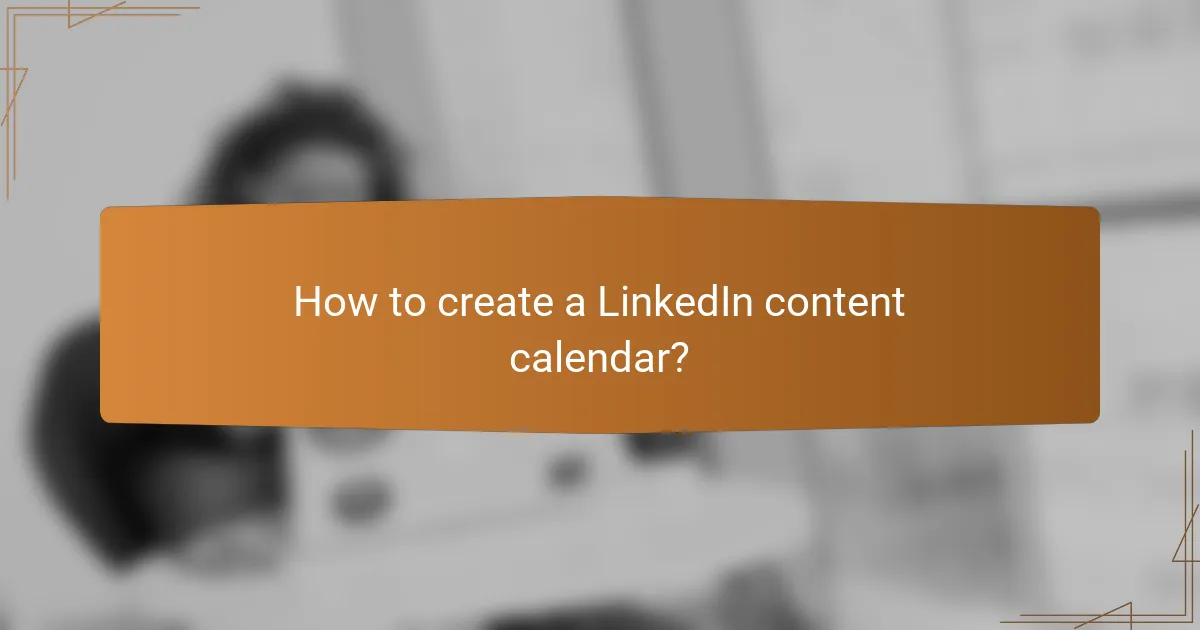Creating a LinkedIn content calendar is essential for enhancing your professional branding and maintaining consistency in your posts. By strategically planning your content, you can stay organized, engage your audience effectively, and reinforce your brand’s identity across the platform.

How to create a LinkedIn content calendar?
Creating a LinkedIn content calendar involves planning your posts to enhance your professional branding and ensure consistency. A well-structured calendar helps you stay organized, engage your audience effectively, and meet your content goals.
Identify target audience
Understanding your target audience is crucial for creating relevant content. Consider demographics such as industry, job titles, and interests to tailor your messaging. Utilize LinkedIn analytics to gain insights into your current followers and adjust your strategy accordingly.
Creating audience personas can help visualize who you are speaking to, making it easier to craft content that resonates. Regularly revisit and refine these personas as your audience evolves.
Set content goals
Establish clear content goals to guide your LinkedIn strategy. Goals may include increasing brand awareness, generating leads, or establishing thought leadership. Ensure your objectives are specific, measurable, achievable, relevant, and time-bound (SMART).
For example, you might aim to increase engagement by 20% over the next quarter or gain a specific number of followers within a set timeframe. Regularly assess your progress to stay on track.
Choose content types
Selecting the right content types is essential for maintaining audience interest. Consider a mix of articles, infographics, videos, and polls to diversify your offerings. Each type serves different purposes and can engage your audience in unique ways.
For instance, articles can showcase your expertise, while videos can provide a more personal touch. Aim for a balance that aligns with your goals and audience preferences.
Establish posting frequency
Determining how often to post is vital for consistency. A common recommendation is to post 2-5 times per week, depending on your audience’s engagement levels and your content capacity. Regular posting helps keep your brand top-of-mind.
Monitor engagement metrics to find the optimal frequency for your audience. If engagement drops, consider adjusting your posting schedule or content type to better meet their needs.
Utilize scheduling tools
Scheduling tools can streamline your LinkedIn content management. Platforms like Buffer, Hootsuite, or LinkedIn’s native scheduling feature allow you to plan and automate posts, saving time and ensuring consistency.
Choose a tool that fits your needs and budget, and take advantage of analytics features to track performance. Regularly review your content calendar to make adjustments based on what resonates most with your audience.

What are the benefits of a LinkedIn content calendar?
A LinkedIn content calendar helps streamline your posting strategy, ensuring regular updates and enhancing your professional presence. By planning your content in advance, you can maintain consistency, strengthen your branding, and improve engagement with your audience.
Improved consistency
Consistency in posting is crucial for maintaining visibility on LinkedIn. A content calendar allows you to schedule posts regularly, helping you stay on your audience’s radar. Aim for a frequency of at least once a week to keep your profile active and engaging.
To achieve this, consider setting specific days for different types of content, such as industry insights on Mondays and personal achievements on Thursdays. This structure not only keeps you organized but also sets expectations for your audience.
Enhanced professional branding
A well-planned content calendar supports your professional branding by allowing you to curate content that aligns with your career goals and values. By consistently sharing relevant articles, insights, and personal experiences, you can position yourself as a thought leader in your field.
Focus on creating a mix of content types, such as informative posts, personal stories, and industry news, to showcase your expertise. This variety helps reinforce your brand identity and makes your profile more appealing to potential connections and employers.
Better engagement metrics
Using a content calendar can lead to improved engagement metrics on your LinkedIn posts. By analyzing when your audience is most active, you can schedule posts for optimal visibility, leading to higher interaction rates. Aim to post during peak hours, typically mid-morning or early afternoon on weekdays.
Track your post performance regularly to identify which types of content resonate most with your audience. Adjust your calendar based on these insights to enhance engagement further. For example, if video content receives more likes and shares, consider incorporating more videos into your strategy.

How to align your content with professional branding?
Aligning your content with professional branding involves ensuring that your messaging, tone, and visuals consistently reflect your brand’s identity. This creates a cohesive presence that resonates with your audience and reinforces your professional image.
Define brand voice
Your brand voice is the distinct personality that comes through in your content. It should reflect your values and resonate with your target audience, whether it’s formal, conversational, or authoritative.
To define your brand voice, consider creating a style guide that outlines key characteristics, tone, and language preferences. This guide will help maintain consistency across all your LinkedIn posts and interactions.
Incorporate visual identity
Visual identity includes your logo, color palette, and typography, which should be consistently used across all content. This helps create a recognizable brand that stands out in a crowded marketplace.
When posting on LinkedIn, use branded templates for images and infographics. Ensure that your visuals align with your brand colors and style to enhance recognition and professionalism.
Share industry insights
Sharing industry insights positions you as a knowledgeable leader in your field. Regularly posting updates on trends, challenges, and innovations can engage your audience and build credibility.
To effectively share insights, curate relevant articles, write brief analyses, or create original content that reflects your expertise. Aim for a mix of content types, such as articles, videos, and infographics, to keep your audience engaged.

What tools can help with LinkedIn content scheduling?
Several tools can assist with LinkedIn content scheduling, making it easier to maintain a consistent posting strategy. These platforms allow users to plan, automate, and analyze their content, ensuring that professional branding remains strong and engaging.
Hootsuite
Hootsuite is a widely used social media management tool that enables users to schedule LinkedIn posts in advance. With its user-friendly interface, you can easily create and queue content, monitor engagement, and analyze performance metrics all in one place.
When using Hootsuite, consider its bulk scheduling feature, which allows you to upload multiple posts at once. This can save time and streamline your content calendar. However, be cautious of over-scheduling; aim for a balanced mix of promotional and engaging content.
Buffer
Buffer is another popular option for scheduling LinkedIn content, known for its simplicity and effectiveness. It allows users to plan posts and offers a straightforward analytics dashboard to track engagement and reach.
One key advantage of Buffer is its browser extension, which makes it easy to share content directly from web pages. When using Buffer, set a consistent posting schedule to maximize visibility, and regularly review your analytics to refine your strategy based on what resonates with your audience.
Sprout Social
Sprout Social is a comprehensive social media management platform that provides robust scheduling capabilities for LinkedIn. It offers advanced features like social listening and detailed reporting, helping you understand audience interactions better.
With Sprout Social, you can utilize its Smart Inbox to manage messages and comments efficiently. Keep in mind that while it offers extensive features, it may come at a higher price point compared to other tools. Evaluate your needs and budget to determine if its advanced capabilities justify the investment.

How to measure the success of your LinkedIn content?
Measuring the success of your LinkedIn content involves tracking key performance indicators that reflect engagement and growth. Focus on metrics such as engagement rates, follower growth, and content shares to evaluate how well your content resonates with your audience.
Track engagement rates
Engagement rates are a crucial metric for assessing how your audience interacts with your LinkedIn content. This includes likes, comments, and shares, which collectively indicate the level of interest and relevance your posts generate.
To calculate engagement rates, divide the total engagements by the number of impressions or followers, then multiply by 100 to get a percentage. Aim for engagement rates in the low to mid-single digits as a benchmark for effective content.
Regularly review which types of posts receive the most engagement to refine your content strategy. Experiment with different formats, such as articles, videos, or polls, to see what resonates best with your audience.
Analyze follower growth
Follower growth is a key indicator of your expanding reach and influence on LinkedIn. Monitoring how your follower count changes over time can help you gauge the effectiveness of your content and networking efforts.
Track your follower growth on a monthly basis to identify trends. A steady increase suggests that your content is attracting interest, while stagnation may indicate a need for new strategies or topics. Aim for a growth rate of around 5-10% monthly as a healthy target.
Consider using LinkedIn analytics tools to visualize your follower growth and demographics. This data can inform your content creation and help you tailor your messaging to better connect with your audience.
Monitor content shares
Content shares reflect how often your posts are shared by others, indicating their value and relevance. High share rates can amplify your reach and enhance your professional branding on LinkedIn.
To monitor shares, keep track of the number of times each post is shared and analyze which topics or formats lead to higher share rates. Posts that provide actionable insights or valuable information tend to perform better.
Encourage sharing by including clear calls to action in your posts. Remind your audience to share if they find the content useful, which can help increase visibility and engagement.


